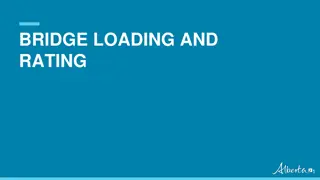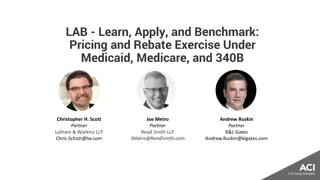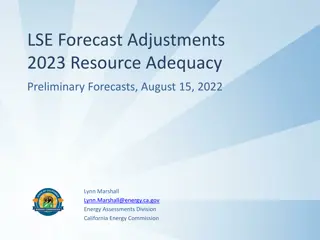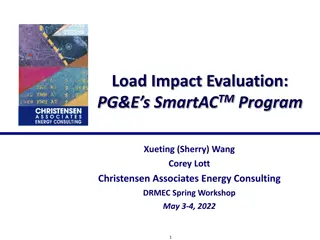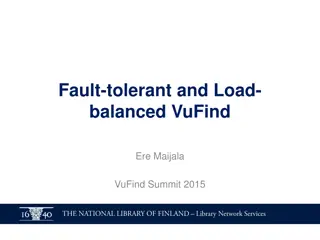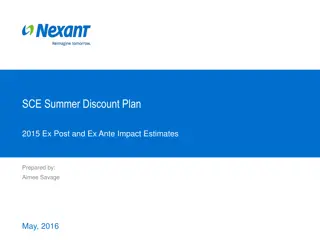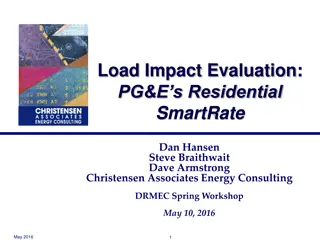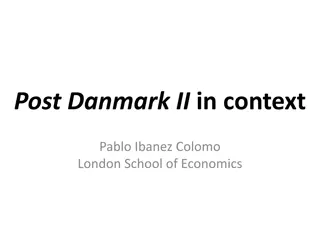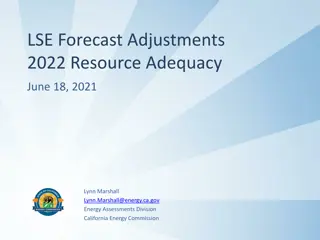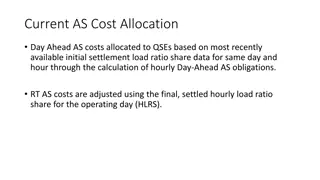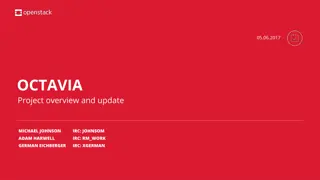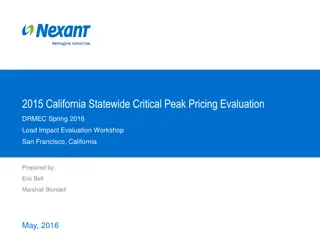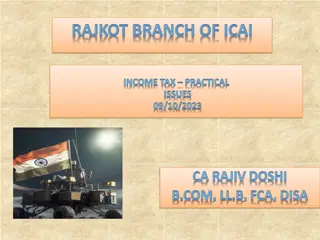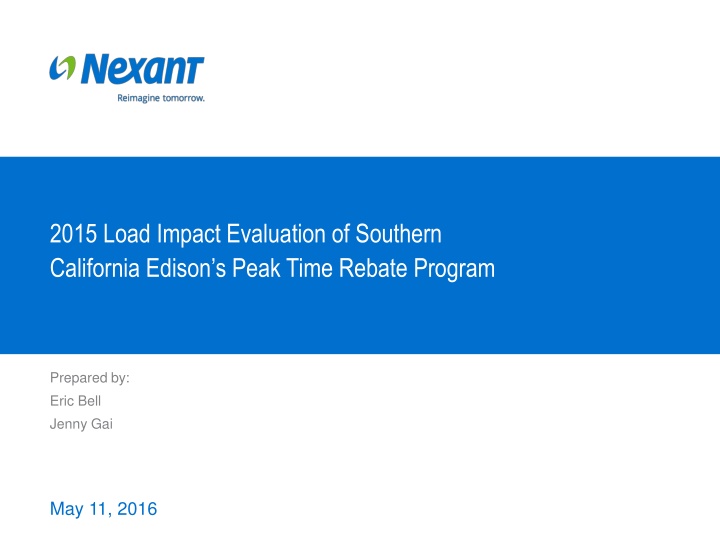
2015 Load Impact Evaluation of SCE's Peak Time Rebate Program
This evaluation report focuses on Southern California Edison's Peak Time Rebate Program for 2015, analyzing its impact on customer segments and presenting methodologies, results, and recommendations. The program overview, enrollment forecast, and outcomes for various subgroups are discussed in detail.
Download Presentation

Please find below an Image/Link to download the presentation.
The content on the website is provided AS IS for your information and personal use only. It may not be sold, licensed, or shared on other websites without obtaining consent from the author. If you encounter any issues during the download, it is possible that the publisher has removed the file from their server.
You are allowed to download the files provided on this website for personal or commercial use, subject to the condition that they are used lawfully. All files are the property of their respective owners.
The content on the website is provided AS IS for your information and personal use only. It may not be sold, licensed, or shared on other websites without obtaining consent from the author.
E N D
Presentation Transcript
2015 Load Impact Evaluation of Southern California Edison s Peak Time Rebate Program Prepared by: Eric Bell Jenny Gai May 11, 2016
Presentation overview Program Overview Ex Post Methodology Ex Post Results Ex Ante Methodology Enrollment Forecast Ex Ante Results Ex Post Results for Program Subgroups Recommendations and Conclusion 2
SCE Save Power Days (SPD) program overview SCE may call PTR events on a day-ahead basis year-round on non- holiday weekdays. Customers signed up for notification receive phone, text message or email alerts that PTR credits are in effect from 2 to 6 PM the following day Most customers earn a rebate of $0.75 per kWh reduced Customers with approved enabling technology, such as programmable communicating thermostats (PCT), are eligible to earn an additional $0.50 per kWh reduced, for a total incentive of $1.25 per kWh Bill credit is calculated based on 2 to 6 PM load reduction below customer- specific reference level (CSRL) The CSRL is defined as the average 2:00 PM through 6:00 PM usage for the highest three (3) of five (5) previous weekdays, excluding PTR event days and holidays. Customers with event period usage below their CSRL receive PTR credits. 8 Events in 2015 7/1, 7/29, 7/30, 8/17, 8/26, 8/27, 9/9, 9/10 4
SCE Save Power Days (SPD) program overview The 2015 SCE PTR load impact evaluation focused on the following three customer segments: Opt-in alert PTR customers (Opt-in): Customers that voluntarily enrolled in PTR event notification by phone, text message, or email (approximately 380,000 customers); Customers with in-home displays (IHD): Customers who received IHDs as part of pilot program (approximately 750 customers); and Third-party PCT customers: Customers that have a programmable communicating thermostat (PCT) and who participated in the third-party PCT study, which enabled demand response during 2015 PTR events (approximately 3,800 customers). 5
Overview of ex post analysis methodology Reference loads for the PTR impact estimates were calculated using a matched control group drawn from the non-participant population Control group was selected using propensity score matching to find non-participant customers who had similar load shapes to PTR customers on proxy event days (within the same weather station area and average daily energy use quartile) Probit model matching variables: Average Daily kWh, Hourly kWh: 11 AM to 9 PM The analysis included the entire population of PTR customers (Not based on a sample) A sample of SCE s residential non-participant population was used as a pool for matching (approximately 1.8M customers) Load impact estimates were based on a difference-in-difference analysis Difference in loads for the participant and control group customers on the event day minus the difference in load between the two groups on similar, nonevent days 7
Average event ex post load impact estimates (2-6 PM) Aggregate Load Impact (MW) Heat Buildup (Avg. F, 12 AM to 5 PM) Avg. Participant Group Number of Customers Avg. Load w/ DR (kW) Avg. Load Impact (kW) % Load Impact Reference Load (kW) Opt-in PTR IHD PCT 324,681 634 2,682 1.86 2.19 2.31 1.79 2.12 1.53 0.08 0.07 0.78 4.1% 3.5% 34.2% 24.5 0.05 2.08 80.4 81.3 80.4 Opt-in PTR load impacts were similar to the 2014 impacts PCT average load impacts per customer increased by 30% compared to 2014 Reference loads increased by approximately 3% in 2015 compared to 2014 Average heat buildup 80.4 F in 2015 compared to 77.8 F in 2014 Significant customer turnover between years (46% of 2014 PCT customers left the program before 2015, 44% of customers in 2015 were new to the program) Resolved NEM customer missing data issue from prior years (NEM 16% of PCT population) Note: For each event day, if a PTR participant was also activated for SDP SCE s AC cycling program that participant was removed from the ex post load impact estimates for PTR in order to avoid overestimating PTR impacts 9 [1] Average population across all events for the season. SDP customers are excluded from the count on SDP event days, lowering the overall average across all events.
Aggregate impacts for statewide system peak day Load Impact (MW) Event Date Hour Ending Opt-in PTR IHD PCT 15 30.1 0.2 3.5 16 34.3 0.1 3.7 9/10/2015 17 34.9 0.1 3.4 18 31.5 0.1 2.9 CAISO System Peak: September 10, 2015 at 4:53 PM (corresponding to the HE 17 period) SCE s peak occurred September 8, 2015 at HE 17 (no event was called) 10
Aggregate load reductions (MW) by event day and group * Indicates PTR events that overlap with SDP events 11
Average event aggregate ex post results for PCT customers PCTs delivered substantial pre-cooling before the event period In the hour before the event, the load impact was negative 31% (-1.42 MW) (i.e., there was a large increase in cooling load before the event began, intended to mitigate discomfort during the event period) Similarly, the load impact was negative 17% (-1.27 MW) during the first hour after the event to make up for the increase in temperature during the event period Avg. Load Reduction for Event Window (MW): 2.08 % Load Reduction for Event Window: 33.7% Overall energy use throughout the day was 3.8% lower 12
Comparing PCT vs Opt-in PTR load impacts PCT Opt-in PTR Avg. Load Reduction for Event Window (kW): 0.78 % Load Reduction for Event Window: 33.7% Avg. Load Reduction for Event Window (kW): 0.08 % Load Reduction for Event Window: 4.1% 0.72 kW There is a significant difference between PCT and Opt-in PTR customers PCT customers exhibit a 0.72 kW higher on-peak reference load 13
Overview of ex ante methodology Ex ante load impacts calculated for PCT customers only IHD customers not included because it is a pilot study and not expected to become a full scale program Opt-in PTR customers not included because the portion of the program without technology (i.e., PCTs) was expected to be decommissioned in 2016 after filing the load impacts it was determined the program will likely remain in operation for one additional year due to the Aliso Canyon gas leak Ex ante impact estimates are based on: 1. Ex post estimates calculated by LCA (Only impacts from 2015 were used to estimate the ex ante model) 2. Regression model developed to explain hourly ex post impacts as a function of temperature 3. The model was then used to predict hourly impacts based on the set of ex ante weather conditions Each step was performed separately for PCT-only customers and for customers dually-enrolled in SDP Hourly whole-house reference loads were also predicted for each set of ex ante weather conditions based on 2015 observed loads 15
Enrollment forecast for PCT customers SCE expects significant growth in the PCT customer segment over the planning horizon as customer adoption of PCT (smart thermostat) technology is expected to increase significantly in coming years By the end of year 2026, SCE expects to have approximately 106,000 PCT customers on the program. 2015 year-ending enrollment: 4,238 The difference between 2015 year-end and 2016 year-beginning enrollments is driven by targeted marketing efforts as the PTR program focuses on PCT-enabled customers Year-Beginning Enrollment 4,710 16,745 25,024 38,969 47,378 55,787 64,196 72,605 81,014 89,423 97,832 Net Incremental Enrollment 12,035 8,279 13,945 8,409 8,409 8,409 8,409 8,409 8,409 8,409 8,409 Year Year-Ending Enrollment 2016 2017 2018 2019 2020 2021 2022 2023 2024 2025 2026 16,745 25,024 38,969 47,378 55,787 64,196 72,605 81,014 89,423 97,832 106,241 17
PCT ex ante load impact estimates for August (2017 & 2026) Average per Customer (kW) Aggregate PCT-only (MW) Aggregate Dually-enrolled (MW) Program Year Total Aggregate (MW) Weather Year Total Enrollment 9.2 3.1 23,644 12.3 2017 SCE 1-in-2 0.52 40.8 13.9 104,839 54.7 2026 9.0 3.0 23,644 12.1 2017 CAISO 1-in-2 0.51 40.1 13.5 104,839 53.6 2026 In 2014, the ex ante estimates for August 2017 under SCE 1-in-2 weather conditions were: Average per customer: 0.41 kW Aggregate: 5.7 MW The difference is driven by: The higher average ex post load impacts for 2015 relative to 2014 The forecasted enrollment used in the 2015 analysis represents an increase of almost 9,700 customers compared to the enrollment used in 2014 19
Comparison of PCT ex post and August 2017 ex ante estimates under SCE 1-in-2 weather conditions Average Load Impact Aggregate Load Impact August 2017 temperatures under 1-in-2 conditions are most similar to the temperatures for the August 17, 2015 event As expected, the average 2-6 PM impacts are very similar, with the event ex post impacts slightly smaller due to the slightly cooler temperature When scaled by the number of participants, the August 2017 estimated aggregate load impacts are much larger due to the 23,644 forecasted participants compared to the 2,619 customers participating on the August 17, 2015 event day 20
Opt-in PTR ex post load impact estimates by customer category for the average event (2-6 PM) Avg. Avg. Load Impact (kW) % of Heat Buildup (Avg. F, 12 AM to 5 PM) Number of Customers Avg. Load w/ DR (kW) % Load Impact Reference Load (kW) Aggregate Load Impact Customer Category LCA - LA Basin 269,026 1.84 1.77 0.07 3.8% 78% 80.5 LCA - Outside LA Basin 23,837 2.08 1.97 0.11 5.1% 10% 81.3 LCA - Ventura 31,818 1.87 1.78 0.09 4.9% 12% 78.7 Region - South of Lugo 95,244 2.15 2.08 0.07 3.3% 28% 82.8 Region - South Orange County 37,545 1.35 1.31 0.05 3.3% 7% 77.3 Region - Neither 191,892 1.82 1.73 0.08 4.6% 65% 79.8 Non-SDP 290,935 1.81 1.74 0.07 3.7% 79% 80.2 SDP 89,991 2.26 2.10 0.16 7.2% 60% 81.3 Non-CARE 214,177 1.94 1.87 0.07 3.7% 62% 80.0 CARE 110,504 1.71 1.63 0.08 5.0% 38% 81.0 Avg. kW Less than 1 kW 231,361 1.32 1.25 0.07 5.2% 65% 79.8 Avg. kW More than 1 kW 93,320 3.25 3.16 0.09 2.8% 35% 81.7 Alert Type - Text Only 71,533 1.97 1.86 0.11 5.6% 32% 80.7 Alert Type - Phone Only 29,834 1.69 1.57 0.13 7.5% 15% 80.1 Alert Type - Email Only 223,314 1.85 1.79 0.06 3.1% 52% 80.3 Non-NEM 307,469 1.88 1.80 0.07 3.9% 93% 80.3 NEM 17,212 1.47 1.36 0.10 7.1% 7% 81.6 Non-SDP Non-NEM 276,556 1.82 1.76 0.06 3.5% 73% 80.2 Non-SDP NEM 14,379 1.45 1.35 0.10 6.9% 6% 81.5 SDP Non-NEM 82,437 2.31 2.15 0.17 7.2% 56% 81.3 SDP NEM 7,554 1.57 1.46 0.12 7.3% 4% 81.7 All Customers 324,681 1.86 1.79 0.08 4.1% 100% 80.4 22
Recommendations and Conclusions PTR program is dispatched from 2-6 PM, whereas the resource adequacy (RA) hours are from 1-6 PM PCTs precool during the hour before the program event, resulting in a significant negative load impact during the first hour of the RA window calculation Difference in the average hourly load impact between the program event window and the RA window is 0.26 kW This difference results in a nearly 33% lower average hourly impact for the RA window directly attributable to the timing of the program event hours relative to the RA hours Given that SCE plans to only include PCT-enabled customers moving forward with the PTR program, Nexant recommends SCE take this issue into consideration for any future changes in program design 24
For comments or questions, contact: Dr. Eric Bell Managing Consultant EBell@nexant.com Nexant, Inc. 101 Second St., Ste 1000 San Francisco, CA 94105 (415) 369-1197 25
Appendix 26
Program Overview Brief history of SPD (PTR) program eligibility In 2012 and 2013, PTR was the default rate option for residential customers with a smart meter (nearly everyone was eligible for a rebate) Additionally, SCE encouraged residential customers to directly enroll in notifications of PTR events by email, text message and/or phone My Account customers were defaulted onto email PTR notifications Default notification customers were ultimately contacted and asked if they would like to opt-in for PTR notifications, dropping non-responsive and declining customers from the program Starting in 2014, SCE required that residential customers directly enroll in the SPD program to receive notification in order to receive PTR credits 27
Evaluation Objectives Evaluation objectives Customer Segment Opt-in PTR IHD PCT Ex Post Ex Ante Ex post Estimate hourly load reductions on the eight 2015 PTR event days (aggregate and per- customer level) Estimate load reductions for each SCE local capacity area (LCA) and for areas affected by the SONGS closure (South of Lugo and Southern Orange County) Ex ante Forecast 2016 2025 PTR hourly ex ante load impacts for a 1-in-2 and 1-in-10 weather year by month, coincident with SCE and CAISO monthly system peak conditions (aggregate and per- customer level) Estimate ex ante load reductions for each LCA and for areas affected by the SONGS closure 28
Ex Post Methodology Matched control group There were many non-event weekdays with similar load as event days, which is ideal for developing a matched control group *PTR event days are marked by squares 29
Ex Post Methodology Matching results Report includes many validations to show that the model produced accurate estimates Difference-in-differences was used to calculate impacts, but the magnitude of the adjustment was small 30
Ex Ante Methodology Ex post impacts versus Mean17 for PCT customers Population Weighted Ex Post Impacts versus Mean17 for PCT-Only Customers Population Weighted Ex Post Impacts versus Mean17 for Customers Dually Enrolled with SDP 31
Ex Ante Results Relationship between ex post and ex ante estimates (PCT-only plus dually enrolled with SDP) Factor Aggregate Load Impact (MW) Explanation Combined PCT-only & dually enrolled with SDP 2016 enrollment is projected to increase considerably compared to 2015 Only impacts from 2014 were used to estimate the ex ante model due to program changes Ex-Post Impact 2.08 Ex-Post Impact with Ex-Ante Enrollment* 13.1 Ex Ante Model Ex Post Event Window* 14.1 The event window includes an hour that is not in the RA window reduces impacts by 33% Ex post mean17 = 80.4 CAISO mean 17 = 79 Ex post mean17 = 80.4 SCE mean 17 = 76 Ex post mean17 = 80.4 CAISO mean 17 = 84 Ex post mean17 = 80.4 SCE mean 17 = 83 Ex Ante Model RA Event Window* 9.5 CAISO 1-in-2 8.3 SCE 1-in-2 7.68 CAISO 1-in-10 9.66 SCE 1-in-10 9.5 * Assuming 2015 average event day under SCE specific 1-in-10 conditions 32


